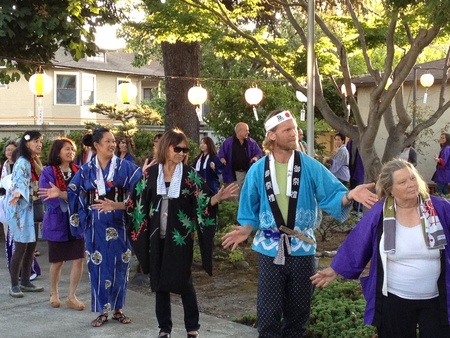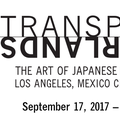About a year ago, my mother called to tell me that my grandmother had stopped eating. It was expected that she would deteriorate rapidly in the coming weeks, maybe days. Come home, she said, it was time to say goodbye.
Within a day, I found Bachan at my aunt’s house in Fresno. As I held her fragile hands between my own, I was especially sensitive to feeling her bones swimming beneath the skin, its surface freckled with age and blue with veins, still delicately vital.
Prominently displayed in her room was the family butsudan, a solemn, lacquered shrine devoted to ancestor worship. Butsudans are a bit like books to me- with two sets of shuttered doors, one paneled, one solid, that opened to more tiers where candles and photographs of the deceased are placed. Before the butsudan sits a gilded cushion on a carved pedestal, a resonating bowl for awakening distracted ancestors, Bachan’s crystal ojizu with its rich purple and white tassel. In this fashion, she remained connected to the worlds of the living and dead.
I sat in fear that this was the last chance to thank her for the immense, infatigable love she surrounded me with throughout my entire life. We fluttered around the subject of life’s great rewards and all the good times. As I stood to leave, she patted me again reassuringly, clear-eyed and chirped, “You’ll see me again!”
It wasn’t until later, on my train ride back to Oakland that I pondered one of the enigmas of being raised Buddhist and the weight of Bachan’s comment. We are taught that with death, the unenlightened are reborn into this world, again destined to seek nirvana. Most of us don’t contemplate the reincarnation wheel with much regularity let alone consider when we’re going to bump into the recently deceased next, and whether they might be disguised as a roundworm, a morning glory vine, or even a ghostly human. What I failed to remember on that journey home was the fact that it was early August, and I was unwittingly speeding directly into Obon season.

Obon has been held annually in Japan since 657 A.D. and even today, millions of Japanese living in metropolitan cities flock to their hometowns to celebrate. “Obon” is an abbreviation of “urabon”, the Japanese transliteration of the Sanskrit word Ullambana which literally means “to hang upside down”, implying the unbearable suffering born when you’re hanging upside down, or forced to bear the discontent and unfulfilled desires of your earthly life.
The legend of Obon proportedly is as follows: Mokuren Sonja, a disciple of the Sâkyamuni Buddha, gifted with supernatural powers bestowed upon his priestly devotion, visits his mother who has passed to the spirit world, only to discover that she has fallen onto the path of hungry ghosts and is in great suffering. To release her from her wanderings, he brings her food and makes offerings at his local temple, then bursts into spontaneous dance when she and seven generations of ancestors are released from their earthly desires. Obon then became a ritual of both filial piety and to offer gifts of food to the deceased, coinciding with the end of summer and the beginning of the harvest season.
Thus, at the peak of summer’s intensity, when the skies boil with humidity and a witching shrill of dying cicadas, the spirits of our ancestors descend back to earth to visit kin. To pay respect and homage to who they once were, offerings of rice, cakes, fruits and vegetables—usually the most splendid and choicest, symbolizing the fruition of the family’s efforts— are laid at the butsudan and occasionally at the front door of the household. In order to properly guide the spirits of one’s ancestors, lanterns or mukaebi, small bonfires, are lit on the night of Obon, filling the night with the soft pulse of light suffused through paper.
Additionally, in the Hiroshima area where my great grandparents immigrated from, elaborate hexagonal paper lanterns, both multi-colored and white, are placed at the ancestral graves. The white lanterns are for those who passed away during Aug. 16 of the previous year till Aug. 15 of the current year.
Although an exact evolution of Obon cannot be definitely traced, the festival has become synonymous with ritual folk dancing performed at night. Bon Odori (dance) is itself an offering of joy and celebration, a magical twilit evening when one can literally dance in tandem with the dead.
It was likely in a fit of nostalgia for ancestors left in distant villages in Japan that Obon became one of the predominant Japanese traditions that survived the centuries old lag between United States and the home country. The first Bon Odori in U.S. Territory was performed in Hawaii in 1910 (which technically wasn’t an actual U.S. state, but was the earliest immigrant community of Japanese migrant workers.)
Twenty years later, the Jodo Shinshu priest Reverend Yoshio Iwanaga introduced the Bon Odori to temples in California, Oregon, Washington and Canada. The first organized Bon Odori in the continental United States was held in the auditorium of the Buddhist Church of San Francisco in 1931. Bon Odori is still performed outdoors, the dancers clad in summer yukata, moving in concentric circles around a raised platform called a yagura.
Although I grew up attending the Obon festival in West Fresno, I never participated in the odori itself, and was more content just to prowl the stalls for dollar plates of somen salad, paper cones of shave ice, or to spend quarters playing carnival games. Death and the observance of the past were the furthest things possible from my mind.
A cursory look at the Rafu Shimpo newspaper in late June will give the reader a listing of at least a dozen Obon festivals scheduled in Southern California alone: San Fernando, Senshin, West Covina, Gardena, Little Tokyo, Oxnard, Pasadena. If you were to add the Central Valley and Northern California Buddhist temples, you could count close to four dozen Obon celebrations to choose from on any given year. Beyond California’s borders, Obon is celebrated in Hawai’i, Seattle, Chicago, as well as in Sao Paulo, Lima, and Manila.
Today I am in Berkeley, California. The dancing begins at seven, and many people arrive early for the teriyaki dinners and to get dressed with the assistance of several obasans who truss you into your yukata mercilessly. The professional dancers who circle in the center wear uniform indigo and white yukata of a decidedly modern style. It is the young girls who provide the candy-colored pyrotechnics of the evening, wearing fuschia tipped yukata cascading with grape, tangerine and jade profusions of chrysanthemums, koi, irises and even fireworks on their hems and sleeves.
As the day wanes, gem-like lanterns strung along the block are lit, glowing in the crepuscular light. Up on the yagura, a microphone squeals. The reverend welcomes the crowds to Obon and calls us to remember those who have passed in the recent year. We bow our heads, breathe, and somewhere the music starts. We shuffle forward, always in a circle, returning to where we began.
We are taught that Obon encourages the practice of dana, selfless giving, to all beings, and to reflect the universal experience that in living life, we must know loss. However, in knowing true loss, we begin to understand the meaning of love.
Bachan didn’t, in fact, expire quickly as we had feared. When last I saw her at a banquet dinner in Fresno celebrating her birthday, she seemed genuinely surprised at the cake placed before her, ablaze in candles too many to signify anything beyond a life well journeyed.
With candles amassing in coronas of gold reflected in her eyes, she clasped her hands in sheer delight, exclaiming, “Is this for me?” before gathering every ounce of energy left in her and blowing with all the breath that she could possibly muster. In an instant, the room went black.
* This article was originally published in the Rafu Shimpo on July 19, 2012.
© 2012 Patricia Wakida






